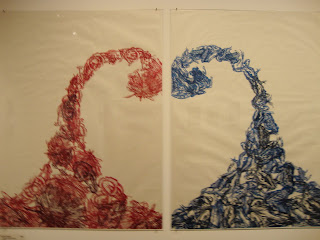
Thursday, November 12, 2009
A Heart Warming Experience...

Thursday, October 29, 2009
Open-mindedness and Broad Variety of Art...

Thursday, October 15, 2009
Floating Between The Heavens and The Earth

Thursday, October 8, 2009
Curious Silver Star...


At Midway Contemporary gallery in North Minneapolis, MN hangs a giant 98x98x21 in. silver star. It is made from steel and painted with enamel (“The Secret Life of Objects.”). As you can see in the second photo, there is a orange glow reflecting off of the white wall because the back of the star is painted bright neon orange. Also, two of the five pointed star's corners are bent. The left point slightly bent, then the bottom left point is almost bent in half, making the star protrude from the wall it is hung from.
Handforth was born in Hong Kong in 1969 and now is a Miami based artist. He went to school at The Slate School of Fine Art in London. He has had just as many solo exhibitions as group exhibitions.
"Silver Star" was created in 2004. A star itself has many meanings, which includes the astronomical symbol, military power and war (western cultures), distraction (ancient times), and also magical/mystical meanings. The five-pointed star originally represented ten tribes of Israel, which broke away from ruling classes of Judah, Benjamin, and Priests (“Star.”). Silver suggests a "cold" feeling, as opposed to the warmth of gold, yet they both represent wealth. Silver is also traditionally the 25th Wedding Anniversary Gift, along with being a symbolism of aging (the term “silver haired”) (“Silver Color Symbolism.”). Orange is a “warm” color, as opposed to the opposite cold silver. The color symbolizes health and wellbeing, fall (with Halloween), or more commonly warning, as it is often used in traffic. It is a bright color that the human eye is naturally attracted to (“Orange.”).
Handforth’s work often involves narratives. He is not afraid to make strong statements, thus his work commonly has biblical references as well as the state of the world. This piece could most definitely be referring to the Ten Lost Tribes of Israel, which is mentioned in the Hebrew Bible (“Ten Lost Tribes.”).
It could represent a yin and yang, where as the silver is cold (a cold front/mask) and the back/inside a warm orange. It could refer to society, which almost everyone has a cold front without knowing them. Sometimes the “coldness” is more obvious by appearance, which the bent corner could portray.
Also, it could have a positive meaning of wealth and happiness and health.
Another interpretation could be that the riches of the world is in danger.
I was drawn to this pieces because of the scale, irregularity of a 3-D star (the bent corners), and the mysterious bright neon backside. On the back, it is all orange except for the silver paint drippings from the front. But also one leg of the star is painted silver on the back rather than being orange. This caught my eye curiously...
Thursday, September 24, 2009
Asses of Yesterday and Today

This is a statue (bronze I believe) of an old woman planting rice. Her hand is extended comfortably to spread the seeds evenly. The bucket holds the rice. I believe it originated from somewhere in Asia.

These are horse statues (stone and copper?) from China.

This is a Roman statue (Greek copy).

A painting of fruits. Not sure who it's by but they look delicious!
The way I would arrange these pieces is the Greek statue standing next to the three horse statues, butts facing the crowd. I would use platforms to raise the butts to the same level and have the old woman statue standing behind one of them (whichever, I can't decide). The fruits painting would be behind it all, visible past the statues.
I would honestly say the reaction could be humorous or environmentally conscious (or something else, anyone have thoughts?). Humorous because it could seem like the old woman is reaching to touch an ass. Environmental because droppings, once composted and back in the ground, make fertilized earth, great for growing crops... Much like the tasty looking ones in the painting.
Ehh, this isn't very creative. More of a sad joke than anything.
On a lighter note, I haven't been back at the MIA since I studied art after the 1900's (much less stepped foot in the more modern areas of MIA which I never knew about). I nearly died when I saw works by artists like Schiele, Mondrian, Brancusi, Picasso, Carrington, Matisse, Ernst, Kandinsky... What an experience.
Thursday, September 17, 2009
Post-Modern? Shmoderrn!

I went to Highpoint Center (a place more for printmaking) on Friday, September 11th to an art opening as well as a magazine preview party (with Chandra and Kevin). After being lost in Minneapolis for about an hour, we finally (by chance) came across the street which the gallery resided at. Ironically, we made it on time at 7:00pm. But of course, we were unfashionably early and no one was there... above is one of the main pieces in the show.


Thursday, September 10, 2009
Intro
My other blog is http://junkoart.blogspot.com/ though it needs work.
Had a wonderful weekend with Chandra and Steven! We (sort of) did homework and played Blind Body Bowling and went to a gallery opening :) Buddy grouuuuupppppppp uniiiiiittteeeeee!
Have a great day.
-J



